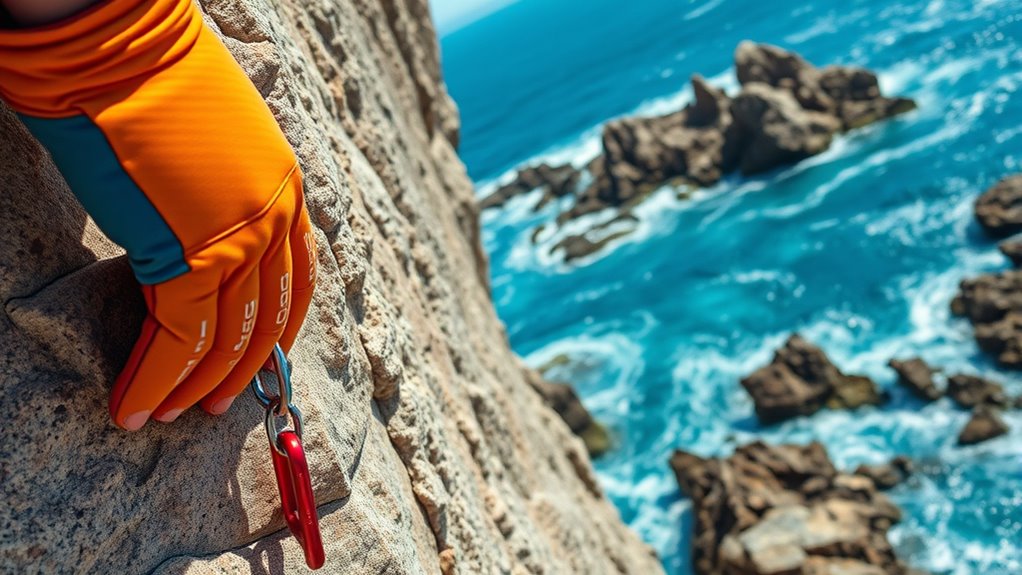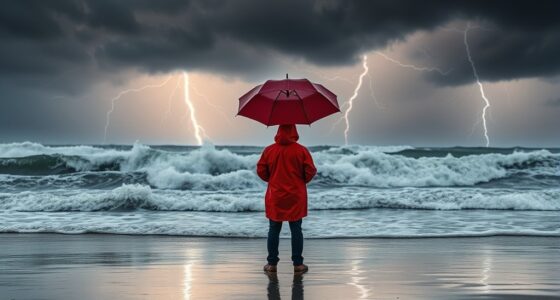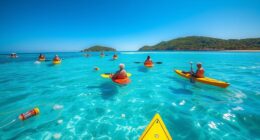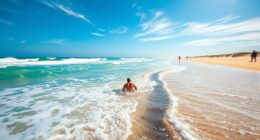To stay safe while coastal rock climbing, choose proper gear like a snug harness, helmet, climbing shoes, and quality ropes. Always perform thorough safety checks on knots, harnesses, and anchors before climbing. Pay attention to tidal and weather conditions, as they impact route access and safety. Use proper techniques such as maintaining three points of contact and staying vigilant for hazards like loose rocks or slippery surfaces. If you keep exploring, you’ll discover how to climb smarter and safer.
Key Takeaways
- Perform thorough safety checks on gear, knots, and anchors before climbing.
- Monitor tide charts and weather forecasts to plan routes and avoid hazards.
- Use proper climbing techniques, maintain three points of contact, and communicate clearly with your partner.
- Inspect the environment for loose rocks, algae, or moss that could pose risks.
- Carry and regularly inspect essential gear like harnesses, helmets, ropes, and quickdraws for safety.
Selecting Appropriate Gear and Equipment
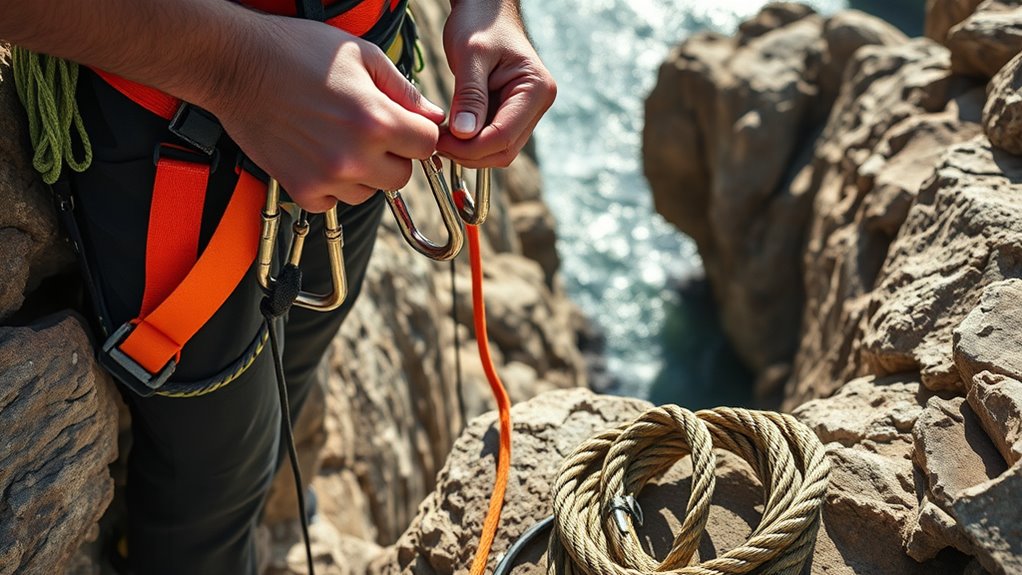
Choosing the right gear is essential for safe coastal rock climbing. You need equipment that suits the unique challenges of seaside cliffs, where waves and wind can be unpredictable. Start with a reliable climbing harness that fits snugly and comfortably, ensuring safety without restricting movement. Use a sturdy helmet to protect your head from falling debris or accidental impacts against rocks. Select climbing shoes with good grip and support, so you can confidently navigate uneven surfaces. Bring a quality climbing rope designed for outdoor use, along with carabiners, quickdraws, and protection devices like cams or nuts. Don’t forget a waterproof chalk bag to keep your hands dry, and carry a personal anchor or belay device for added safety. Proper gear boosts confidence and minimizes risks during your climb. Additionally, understanding industry trends can help you choose the most effective equipment for your specific climbing environment, especially considering advancements in climbing technology that improve safety features. Staying informed about latest safety innovations can also enhance your overall safety approach. Regularly reviewing safety standards ensures your gear remains reliable and compliant with current best practices. Moreover, staying aware of environmental conditions can help you adapt your safety measures to changing seaside weather patterns.
Conducting Pre-Climb Safety Checks
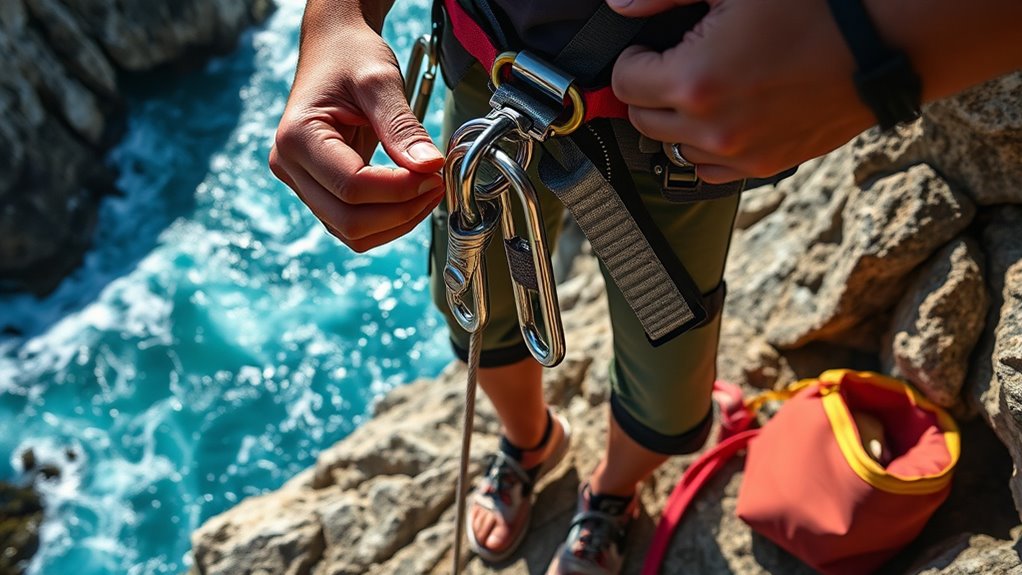
Before you start climbing, it’s vital to perform a thorough safety check of your gear. You’ll want to carefully inspect your equipment for wear or damage and verify that knots and anchors are secure. Taking these steps helps guarantee your safety and sets the foundation for a confident climb. Additionally, understanding sound design techniques can contribute to better communication signals with your climbing partner through audio cues. Regularly reviewing maintenance and longevity practices ensures your gear remains reliable over time, reducing the risk of equipment failure during your climb. Incorporating automation in business practices can streamline your pre-climb preparations, making safety checks more efficient and thorough. Being aware of essential oils for safety can also provide calming effects or alertness boosts if needed during your preparation. Moreover, utilizing innovative planters with advanced moisture control features can serve as a reminder to check your hydration and gear status before ascending.
Equipment Inspection Procedures
To guarantee safety before starting your climb, you need to thoroughly inspect your equipment. Begin by checking your harness for any frays, tears, or worn spots, ensuring all buckles function smoothly. Examine your climbing shoes for damage or excessive wear, as they provide essential grip. Inspect your helmet for cracks or dents and confirm the straps are secure. Next, scrutinize your carabiners and quickdraws for cracks, corrosion, or deformation, and test their locking mechanisms. Verify that your belay device is clean and free of damage. Finally, examine your ropes for cuts, frays, or soft spots, and run your fingers along the entire length to detect any hidden issues. Proper equipment inspection is critical to prevent accidents and guarantee your climb is safe. Additionally, regularly checking the air quality of your environment can help maintain your overall safety and health during outdoor activities. Monitoring glycolic acid use in skincare can also contribute to healthy skin, which is important when outdoor adventures expose you to various environmental factors. Being aware of fellow climbers’ experience levels can further enhance safety by ensuring everyone understands and follows proper procedures. Understanding risk management principles can help climbers respond effectively to potential hazards during a climb.
Knot and Anchor Checks
Ensuring your knots and anchors are secure is vital for a safe climb. Before starting, double-check that all knots are tied correctly and tight. Confirm that the harness is properly secured and that the knots won’t slip under load. Inspect your anchor points, making sure they’re solid and free of damage or wear. Verify that your carabiners are locked and properly positioned. Communicate with your partner to confirm that each of you has checked their gear and knots. Take a moment to review your belay device and backup systems. Remember, a quick but thorough check can prevent accidents. Regular Kia Tuning upgrades can also improve vehicle handling, which is essential for safe and confident climbing trips when transporting gear. Additionally, developing a systematic pre-climb safety checklist ensures nothing is overlooked. Incorporating a gear inspection routine before each climb can further enhance overall safety and climbing safety awareness. Regularly practicing gear maintenance procedures can help identify potential issues before they become hazardous.
Understanding Tides and Weather Conditions
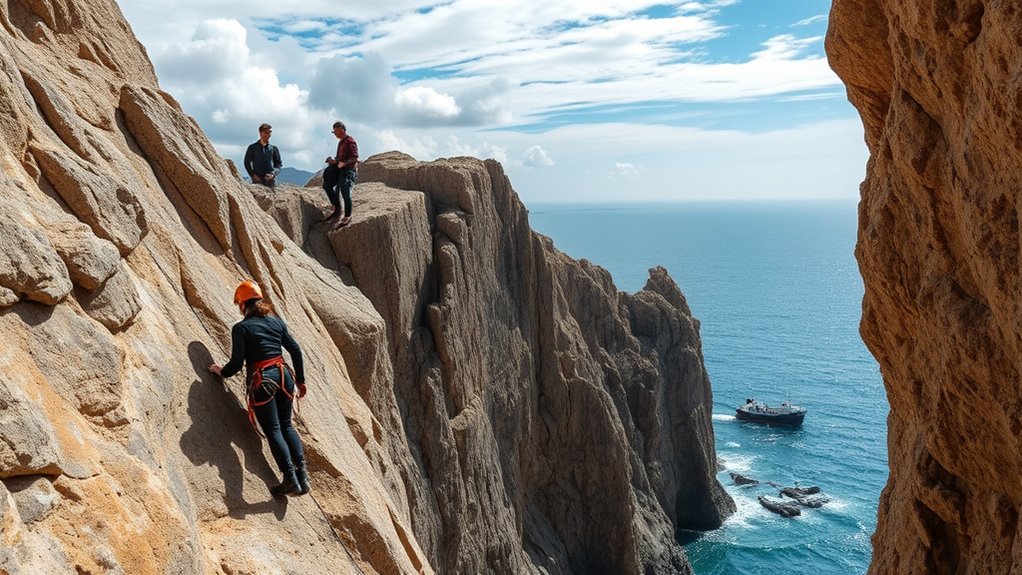
You need to stay aware of tidal schedules to avoid getting caught off guard by rising or falling water levels. Keep an eye on weather patterns, as sudden changes can impact your safety and climbing plans. Understanding how tides and weather affect the coastline helps you make better decisions and stay safe during your climb. Additionally, being aware of environmental influences such as wind or storms can further enhance your safety precautions. Monitoring local ecosystem factors can also help you anticipate unexpected changes in the environment that might affect your climb, including marine activity which could impact coastal conditions. Recognizing coastal erosion patterns is essential for assessing potential hazards and ensuring a safe climbing experience. Incorporating knowledge of heat pump noise levels can also be beneficial for ensuring a comfortable and disturbance-free environment in nearby facilities.
Tidal Schedule Awareness
Understanding tides and weather conditions is essential for safe coastal rock climbing, as these factors directly influence your route and safety. Knowing the tidal schedule helps you plan climbs during safe tide levels, avoiding high tides that may cut off access or cause dangerous waves. It’s important to check tide charts regularly and understand how tides rise and fall throughout the day. Weather can also impact tides and safety, so always monitor forecast updates. Use the table below to visualize key ideas:
| Tidal Phase | Effect on Climbing | Safety Tip |
|---|---|---|
| Low tide | Better access, more rocks exposed | Check tide charts before climbing |
| Rising tide | Water level increases | Avoid low-lying routes |
| High tide | Routes submerged, dangerous | Plan around tidal peaks |
| Falling tide | Receding water, safe to descend | Time your exit accordingly |
| Slack tide | Minimal movement, safe passage | Use slack tide for crossing |
Additionally, understanding tidal patterns can help you anticipate changes in water levels and plan your ascent or descent more effectively.
Weather Pattern Tracking
Monitoring weather patterns is essential for safe coastal rock climbing because changing conditions can quickly alter tides and wave activity. Before climbing, check local weather forecasts for wind, rain, and storm warnings. Strong winds can cause dangerous wave surges, while storms may bring sudden changes in tide levels. Observe cloud formations and weather trends to anticipate shifts that could impact your safety. Keep an eye on barometric pressure, as falling pressure often signals nearby storms. Use reliable weather apps or tide charts to track upcoming conditions. Being familiar with textile line techniques can also help in managing gear and clothing for changing weather. By staying informed, you can plan your climb during calmer periods and avoid unexpected dangers. Regularly monitoring weather patterns helps you respond promptly to changes, ensuring a safer and more enjoyable climbing experience along the coast.
Impact on Climbing Safety
Since tides and weather conditions directly influence coastal rock climbing safety, staying aware of their impact is crucial. Tides can dramatically change the accessibility of routes and increase risks like slippery surfaces or unexpected waves. High tide may cover footholds or make certain sections inaccessible, so plan your climb around tide schedules. Weather changes, such as sudden storms, high winds, or rain, can weaken rock holds and reduce visibility, making climbs more dangerous. Wind can also cause instability or dislodge loose rocks. Always check tide charts and weather forecasts before heading out. Being prepared helps you avoid dangerous situations, ensures better planning, and improves your overall safety while climbing along coastlines. Staying informed minimizes risks and helps you enjoy your climb responsibly.
Mastering Proper Climbing Techniques

Mastering proper climbing techniques is essential to stay safe and conserve energy on coastal rock faces. Focus on maintaining three points of contact at all times—either two hands and one foot or two feet and one hand. Keep your body close to the wall to reduce strain and improve control. Use your legs to push yourself upward rather than relying solely on your arms; your leg muscles are stronger and tire less quickly. Plan your moves ahead of time, looking for footholds and handholds that allow smooth, efficient progress. Keep your hips aligned with the wall to maintain balance. Pay attention to your breathing, staying calm and steady. Consistently practicing these techniques will boost your safety and help you climb more effectively.
Spotting and Belaying Safely

To guarantee safety while coastal rock climbing, you need to focus on spotting and belaying correctly. When spotting, stay alert and position yourself directly beneath the climber’s path, ready to guide or cushion falls. Keep your eyes on the climber’s movements and communicate clearly. Belaying requires maintaining proper tension on the rope, keeping a firm grip, and using a proper belay device. Always pay attention to the climber’s signals and anticipate their needs. Use a stable stance, avoid distractions, and never let go of the brake side of the rope. Regularly check your harness, knots, and equipment before climbing. Effective spotting and belaying create a safer environment, reducing the risk of injury and ensuring both you and the climber stay protected.
Recognizing and Avoiding Coastal Hazards

Recognizing and avoiding coastal hazards is essential for staying safe during your climb. Always stay alert to changing weather conditions, as sudden storms or high winds can cause dangerous waves and slippery surfaces. Watch for loose rocks or unstable sections that could shift or fall unexpectedly. Be aware of tide levels, since rising tides can cut off your exit routes or trap you in hazardous areas. Keep an eye on wave patterns, especially during storms or rough seas, to avoid being caught off guard. Additionally, watch for slippery algae or moss that can make surfaces treacherous. By staying vigilant and evaluating the environment constantly, you reduce risks and ensure a safer, more enjoyable climbing experience along the coast.
Planning Your Climb and Setting Limits

Effective planning is essential before you start climbing along the coast; it helps you stay safe and avoid unnecessary risks. Know your skill level and select routes accordingly. Check weather conditions, tides, and surf forecasts to prevent surprises. Set clear time limits to avoid fatigue and make sure someone knows your plan. Use the following table to evaluate your climb:
| Factor | Considerations |
|---|---|
| Skill Level | Match routes to your experience |
| Weather & Tides | Avoid storms and high tides |
| Equipment Readiness | Confirm gear is complete and functional |
| Partner’s Experience | Climb with someone reliable |
| Time & Limits | Stick to planned duration |
Planning and setting limits keep your climb safe and enjoyable. Be prepared and stay aware of your capabilities.
Emergency Preparedness and Rescue Procedures

Being prepared for emergencies is essential when coastal rock climbing, as conditions can change rapidly and help may be far away. You should always have a plan in place, know basic rescue procedures, and carry essential safety gear. Recognize signs of injuries or distress early to act quickly. Communicate your plans with your climbing partner, and make certain someone knows your location. Practice rescue techniques regularly so you’re ready if needed. Remember these key points:
- Keep a fully stocked first aid kit accessible
- Carry a whistle for signaling
- Know how to perform basic self-rescue skills
- Have a communication device like a phone or radio
- Understand local emergency contacts and procedures
Preparation boosts your safety and confidence, enabling you to respond effectively in emergencies.
Frequently Asked Questions
How Do I Choose the Best Climbing Shoes for Coastal Climbs?
When choosing the best climbing shoes for coastal climbs, consider your specific needs. You’ll want a pair with good grip and water resistance since coastal environments can be wet. Opt for a snug fit to improve control, but avoid tightness that causes discomfort. Look for shoes with a flexible sole for better movement on varied surfaces. Ultimately, try on several pairs to find those that offer comfort and performance in coastal conditions.
What Are Signs of Equipment Wear and When Should I Replace Gear?
Imagine your gear as a trusted friend on your climb. When you notice frayed ropes, worn-out shoes with thin soles, or carabiners that don’t lock smoothly, it’s time to replace them. Cracks, rust, or missing parts symbolize danger. Regularly inspect your equipment before each climb, and don’t hesitate to retire gear when it shows significant wear—safety always comes first to keep your adventures secure.
How Can I Identify Dangerous Tide Changes During a Climb?
You need to stay alert to dangerous tide changes during your climb by checking tide charts before heading out. Watch for rising water levels or rapid waves, which signal an incoming tide. Keep an eye on the water and your surroundings, and listen for sounds of rushing water. If the tide seems to be rising quickly, it’s best to descend safely and avoid getting caught in dangerous conditions.
What Specific Weather Patterns Pose Risks for Coastal Climbing?
When climbing near the coast, you should watch out for weather patterns like sudden storms, high winds, and heavy rainfall, as these can make the rocks slick and unstable. Fog and low visibility also increase danger, making it harder to see your route or spot hazards. Always check weather forecasts before your climb, and be prepared to postpone if unpredictable weather develops. Safety always comes first when facing changing coastal conditions.
How Do I Communicate Effectively With My Partner During Emergencies?
In the spirit of a modern-day knight, you need clear communication during emergencies. Speak calmly, use concise commands, and listen carefully. Establish signals beforehand, like hand gestures or specific words. Keep your partner updated on your status, and don’t hesitate to call for help if needed. Effective communication can be the difference between a safe ascent and a dangerous situation, so stay alert and supportive at all times.
Conclusion
Remember, safety is key when coastal rock climbing. Nearly 80% of accidents happen due to overlooked hazards or equipment failure, so always check your gear and conditions. Stay alert to tides and weather, master proper techniques, and never climb alone. By planning carefully and understanding risks, you’ll enjoy the thrill while minimizing danger. Keep safety top of mind—your adventure depends on it and can be truly rewarding with the right precautions.

